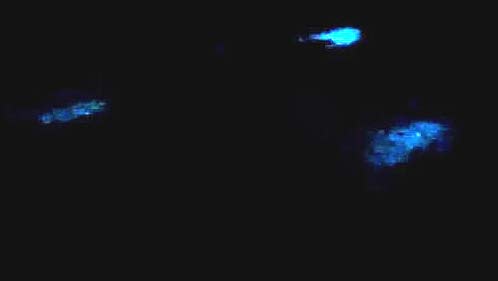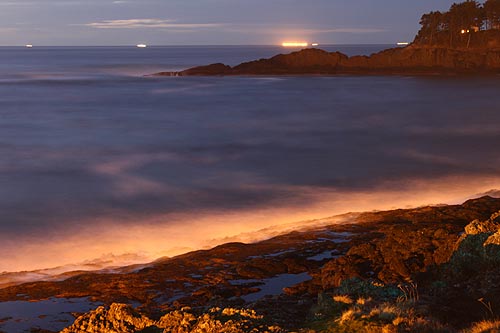Glowing Sand Phenomenon Spotted Again on Oregon Coast
Published 06/05/2011

Includes exclusive listings; some specials in winter
In Cannon Beach:
Includes rentals not listed anywhere else
In Manzanita, Wheeler, Rockaway Beach:
Some specials for winter
In Pacific City, Oceanside:
Some specials for winter
In Lincoln City:
Some specials for winter
In Depoe Bay, Gleneden Beach:
Some specials for winter
In Newport:
Look for some specials
In Waldport
Some specials for winter
In Yachats, Florence
Some specials for winter
(Lincoln City, Oregon) – If after this run of awesome weather and the lingering minus tides this week you still need yet another reason to visit the Oregon coast, then the freakish fun of "glowing sand" could be added to your list. (Above: Lincoln Beach in the wee hours of the night, where glowing sand was seen)
In the wee hours of Sunday morning, this surreal and memorable sight was again seen – this time by BeachConnection.net staff at Lincoln Beach, between Lincoln City and Depoe Bay.
A Depoe Bay local was introduced to the wild sight – her first knowledge of the coastal curiosity - and spent the greater part of an hour shrieking with delight at the discovery.

Photo of a dinoflagellate as seen under a microscope (courtesy Dr. Edith Widder)
The phenomenon shows up as tiny, greenish, blue sparks in the wet sand. Look for an extremely dark beach with no light interference from lights or from the moon, and rub your feet backwards in the wet sand near the tideline. You may see it.
The cause of this is a form of phytoplankton called dinoflagellates – part of the family of microscopic plants that form the bottom of the food chain for marine life. This particular brand is bioluminescent, meaning they give off a glow when disturbed or bumped through internal chemistry processes, much in the same way a firefly does.
Tiffany Boothe of Seaside Aquarium explained a bit more about these exotic creatures.
“Bioluminescence is the light produced by a chemical reaction that occurs in an organism,” said Boothe. “It occurs at all depths in the ocean, but is most commonly observed at the surface. Bioluminescence is the only source of light in the deep ocean where sunlight does not penetrate.”
Boothe said bioluminescence in sea creatures is blue for two reasons. One: blue/green light travels the farthest in water.
“Its wavelength is between 440 to 479 nm, which is mid-range in the spectrum of colors,” Boothe said. “And the second reason is that most organisms are sensitive to only blue light. They do not have the ability to absorb the longer or shorter wavelengths of other lights such as red.”
They can appear in bays, like Nehalem Bay or Yaquina Bay. When you run your hand through the water it will manifest as an eerie bluish glow in the wake of your hand.
Conditions have apparently been ideal for them. First, it’s spring, which brings more blooms of phytoplankton. Second, they seem to be stirred up by rainy, stormy weather, and then “powered up” – in a sense – by a few days of sunshine. These circumstances greatly increase the chance of seeing glowing sand at night. Oregon Coast Hotels for this - Where to eat - Maps - Virtual Tours More photos below of the glowing creatures in the Nehalem Bay, and then photos of the coast at night.




More About Oregon Coast hotels, lodging.....
More About Oregon Coast Restaurants, Dining.....
LATEST Related Oregon Coast Articles
Celtic Light Orchestra shreds the stage while illuminating it. Lincoln City events
Tubular Oddity Back on Oregon Coast: Here's What They Are
Pyrosomes have returned, sometimes called sea pickles - and yes, the glow. Marine sciences
Newport Gets New Sea Jelly Tanks and Glowing Tanks at Oregon Coast Aquarium
Sea nettles, seahorses, lionfish, blue blubbers and glowing stuff
Florence's Fall Fest Includes Kites, Circles in the Sand - and Oregon Coast's...
Nov 9 - 10 brings glowing kites to Driftwood Shores. Florence events
That Which Glows Above and Below Oregon Coast ? And Something New
Bioluminescence, aurora tales and some bizarre rarities captured. Weather
Lincoln City Pride Fest Causes Glow and Glitter in Oregon Coast Burgh
June 29 a family-friendly festival of riotous fun. Lincoln City events
Wondrous Odd Science of Oregon Coast: Glowing, Singing, Flashing
Wondrous Odd Science of Oregon Coast: Glowing, Singing, Flashing. Weather
Weather Tips and Quirky Science Finds for Oregon Coast Spring Break
Things that glow, packing for fun, whales, more
Back to Oregon Coast
Contact Advertise on BeachConnection.net
All Content, unless otherwise attributed, copyright BeachConnection.net Unauthorized use or publication is not permitted















































